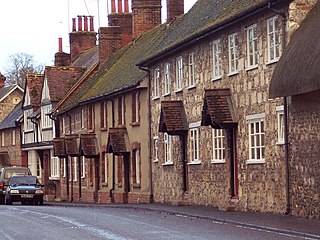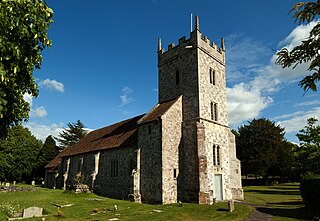
Salisbury is a cathedral city and civil parish in Wiltshire, England with a population of 41,820, at the confluence of the rivers Avon, Nadder and Bourne. The city is approximately 20 miles from Southampton and 30 miles from Bath.

Grafton is a civil parish in Wiltshire, England, in the Vale of Pewsey about 7 miles (11 km) southeast of Marlborough. Its main settlement is the village of East Grafton, on the A338 Burbage - Hungerford road; the parish includes the village of Wilton and the hamlets of West Grafton, Marten and Wexcombe.

Salisbury is a constituency represented in the House of Commons of the UK Parliament since 2010 by John Glen of the Conservative Party.

Barford St Martin is a village and civil parish in Wiltshire, England, about 2.5 miles (4 km) west of Wilton, around the junction of the A30 and the B3089. Barford is known as one of the Nadder Valley villages, named for the River Nadder which flows through the parish.

Berwick St James is a village and civil parish on the River Till in Wiltshire, England, about 7 miles (11 km) northwest of Salisbury, on the southern edge of Salisbury Plain. The parish includes the hamlet of Asserton. At the 2021 census the parish had a population of 137.

Boyton is a village and civil parish in Wiltshire, England. It lies in the Wylye Valley within Salisbury Plain, about 6 miles (10 km) south-east of Warminster and 13 miles (21 km) north-west of Salisbury. The parish includes the village of Corton.

Wylye is a village and civil parish on the River Wylye in Wiltshire, England. The village is about 9+1⁄2 miles (15 km) northwest of Salisbury and a similar distance southeast of Warminster.

Bemerton, once a rural hamlet and later a civil parish to the west of Salisbury, Wiltshire, England, is now a suburb of that city. Modern-day Bemerton has areas known as Bemerton Heath, Bemerton Village and Lower Bemerton.

Britford is a village and civil parish beside the River Avon about 1.5 miles (2.4 km) south-east of Salisbury in Wiltshire, England. The village is just off the A338 Salisbury-Bournemouth road. The 2011 Census recorded a parish population of 592.

Stockton is a small village and civil parish in the Wylye Valley in Wiltshire, England, about 8 miles (13 km) southeast of Warminster. The parish includes the hamlet of Bapton.

Brixton Deverill is a small village and civil parish about 4 miles (6.4 km) south of Warminster in Wiltshire, England.

St Francis Church, Salisbury is an evangelical, charismatic, Church of England parish church in the northern suburbs of Salisbury, Wiltshire, England, consecrated in 1940.

St Lawrence's Church at Stratford-sub-Castle is a 13th-century Grade I listed Church of England parish church, to the north of Salisbury, Wiltshire, England. It stands close to the abandoned settlement of Old Sarum and the River Avon, and is about 2 miles (3.2 km) north of Salisbury Cathedral.

Fugglestone St Peter was a small village, manor, and civil parish in Wiltshire, England, lying between the town of Wilton and the city of Salisbury. The civil parish came to an end in 1894 when it was divided between the adjoining parishes, and today Fugglestone is a largely residential area in the north of Wilton parish; however, the 13th-century parish church survives.
Charles Edwin Ponting, F.S.A., (1850–1932) was a Gothic Revival architect who practised in Marlborough, Wiltshire.

The Old Manor Hospital was a psychiatric hospital in Salisbury, Wiltshire, England. It was established in the early 19th century as a private licensed house called Fisherton House or Fisherton House Asylum, which became the largest private madhouse in the United Kingdom. In 1924, following a change of proprietors, it was renamed Old Manor Hospital and in 1955 it was amalgamated into the National Health Service. From 1813 to 1955 it was owned and managed by members of the same family. The Old Manor Hospital closed in 2003 and was replaced by Fountain Way, a smaller, modern, psychiatric hospital on part of the same site. In 2014 the site was acquired by Quantum Group for development as a residential estate and the conversion of the main building to a hotel.

Blackland is a hamlet and former civil parish, now in the parish of Calne Without, just south-east of the town of Calne, in Wiltshire, England. There is a 13th-century church and an 18th-century country house, Blackland House. In 1881 the parish had a population of 50.

The Church of St Martin, also known as Sarum St Martin, is a Church of England parish church in Salisbury, Wiltshire, England. The church dates from the 13th century and is a Grade I listed building.

The Church of St. Thomas à Becket is the Church of England parish church of Box, Wiltshire, in south-west England. It is one of a number of churches named after Thomas Becket following his martyrdom. The church has 12th-century origins and was substantially remodelled in the 14th, 15th, 18th and 19th centuries. It is a Grade I listed building.

St Osmund's Church is a Roman Catholic church in Salisbury, Wiltshire, England. It was designed by Augustus Pugin in the Gothic Revival style and built in 1847–1848. It is on Exeter Street, opposite Bishop Wordsworth's School, in the city centre. It is a Grade II listed building.




















